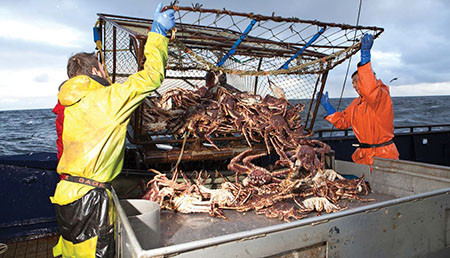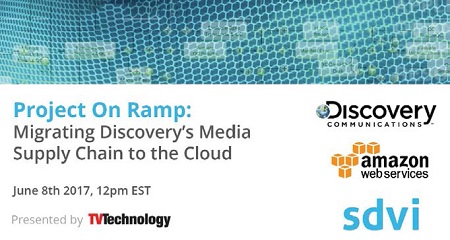‘Deadliest Catch’ Lands in the Cloud
A few years ago, the thought of running a TV channel’s infrastructure on a public cloud was considered abhorrent to many broadcasters. The cry was, “not reliable, not secure, no direct control.”

Brinton Miller
In 2017, things have changed with the likes of Discovery, Disney, Fox, Hearst Television, PBS and others making big cloud moves. Discovery has recently announced they are moving their worldwide channel signal chains to the public cloud. This is big news for our industry and is a proof point of cloud acceptance.
Below is an interview with Brinton Miller, senior vice president of technology strategy and architecture for Discovery Communications. I have known Brinton for many years and have followed Discovery’s move to the cloud.
Al Kovalick:Please tell us about Discovery’s channel empire.
Brinton Miller: Discovery Communications offers a portfolio of premium nonfiction, sports and kids programming brands, reaching 3 billion viewers across pay-TV and free-to-air platforms in more than 220 countries and territories. Our programming [like “Deadliest Catch”] is supplied across hundreds of linear channels worldwide.
Kovalick:What are some of your motivations for moving Discovery’s broadcast workflow chains, including playout, to the cloud?
Miller: Eighteen months ago, we started looking at our global media infrastructure and started thinking about what’s next. We had multiple facilities around the world all running aging playout infrastructures. So, planning for a refresh we needed to ask: “Where do we want to be in a few years? Will any infrastructure we build today meet our future business needs, some of which are unknown? With the speed of technology change, does it make sense to spend the next three years building data centers around the world?”
It quickly became clear that we needed to move to a software-based environment and we wanted to build it in a public cloud. We needed to normalize our technology stack so the tools and systems we use to launch linear products were the same as for our nonlinear products.
The professional video industry's #1 source for news, trends and product and tech information. Sign up below.

“Deadliest Catch” crew members of the Cape Caution emptying a crab pot.
Kovalick:How do you put a price on cloud agility when you do an ROI analysis for new infrastructure?
Miller: Agility is a bonus and not a cornerstone of our financial analysis. That said, a cloud-based channel can be built from scratch and be on air in 20 minutes. Sure, content needs to be prepared, but building the on-air chain is fast.
This compares to about four months using current on-premise methods. Agility allows Discovery to quickly deploy pop-up or digital channels to meet new business needs.
Kovalick:What is your legacy equipment utilization across ingest processing, asset management, file delivery, QA, playout and other workflow components?
Miller: Let’s just say that it is nowhere near 100-percent utilization as measured across a 24-hour/day week. Cloud provides the ability to pay for what we use versus building to a ceiling that will ultimately be a bottle neck for the business.
Kovalick:Did you encounter an internal army of naysayers when your technical staff made the cloud transition proposal?
Miller: Not at the management layer. If a cloud-native competitor is doing this, why can’t Discovery? We have a great culture at Discovery that embraces change. There will always be people that take a bit longer than others. However, for the most part the team embraced the idea.
Most of the negative comments came from incumbent equipment providers. They want to sell us boxes and we were not interested in that discussion. I do think that the vendor space is a bit more open to discussing now 18 months later.
Kovalick:What are some of the challenges to the cloud move?
Miller: Licensing of software can be problematic. Most vendors are in the perpetual license business and this model is aging fast. We wanted “per-widget” consumption models whenever possible.
That said, we needed to accept it for some cases. It was also a challenge to duplicate the real-time signal flow portions of video workflows on a cloud platform not specifically designed for video, but we did it and with the same reliability our business requires.
Kovalick:Did you consider starting with only a few cloud-based channels then migrating others later?
Miller: If you are considering migrating to the cloud, don’t dabble in it. Go all in.
Kovalick:Where did you find savings?
Miller: Oh, many places. Equipment maintenance, support, real estate costs, power, cooling, building services, the list goes on. Our legacy air chain had about 130 racks of on-premise equipment just for our 32 domestic feeds. The cloud-based system has five racks on premise and all the remaining in the cloud. All this amounts to tangible savings for the long-term. Of course, we do channel stat-muxing and satellite up-linking outside of the cloud.

To check out our recent webinar, “Project On-Ramp: Migrating Discovery’s Media Supply Chain to the Cloud,” visit www.tvtechnology.com, click on Webinars under “Resources.”
Kovalick:Let’s talk channel reliability, a huge concern for broadcasters. Can you share some of the architectural principles you followed?
Miller: Our initial rollout is based on Amazon Web Services (AWS). We use S3 for object storage and hundreds of EC2 compute instances for media processing and other functions.
The end-to-end workflow is a mix of file-based processing and real-time streams. We worked with selected vendors to implement a world-class broadcast software architecture.
For reliability, each channel’s signal chain is duplicated in two different Regions (AWS U.S. East Region and Dublin, Ireland Region, for example) and each Region’s signal output is fed to our Sterling, Virginia Broadcast Center where they connect to a simple 2x1 switch. It is there we decide which Region’s feed goes to air. If one faults, we switch to the other. We have created a very reliable system that can withstand both geographical disruptions and multiple equipment failures.
Kovalick:Why did you choose AWS?
Miller: Amazon did a good job reaching out to our industry and this built our confidence and trust in their ability to support our workflows and business needs. We built our foundational flows on Linux and virtualization so that we can migrate to other cloud providers if and when it makes business sense. We deliberately applied design principles to not impede any future migrations.
Kovalick:What new vistas has the cloud opened to you?
Miller: There are many, but I like programmatic workflows and supply chain efficiencies. Quickly setting up signal chains and apps as required by a business and rapidly changing these to meet our needs is very cool.
Al Kovalick is the founder of Media Systems consulting in Silicon Valley. He is the author of “Video Systems in an IT Environment (2nd ed).” He is a frequent speaker at industry events and a SMPTE Fellow. For a complete bio and contact information, visitwww.theAVITbook.com.

